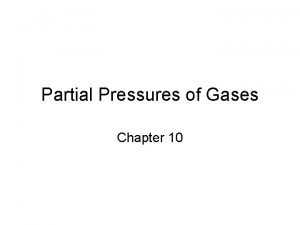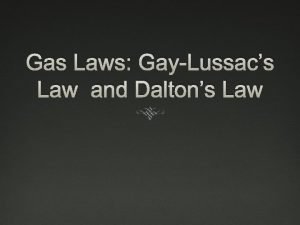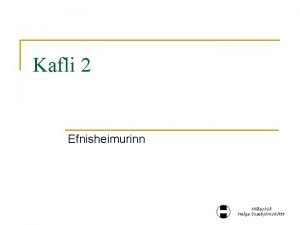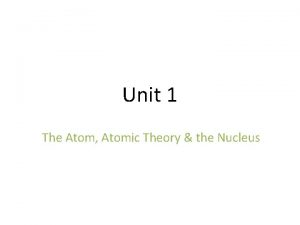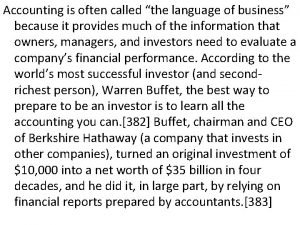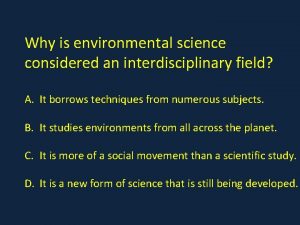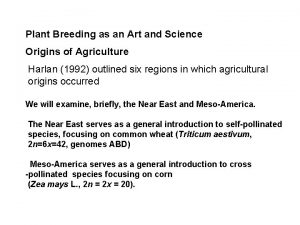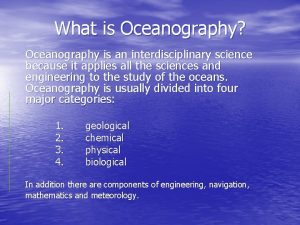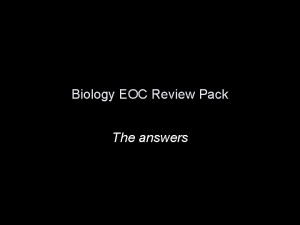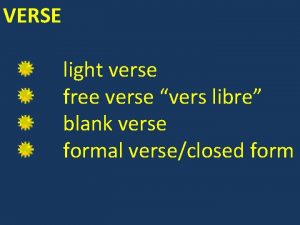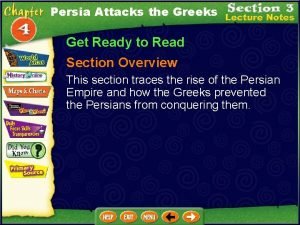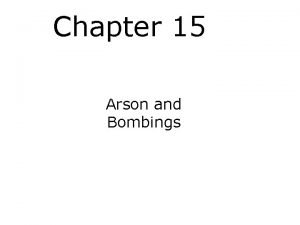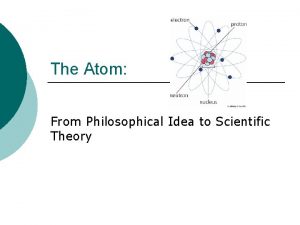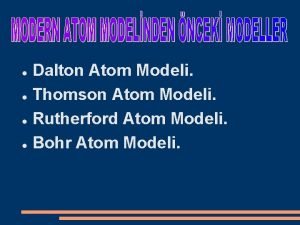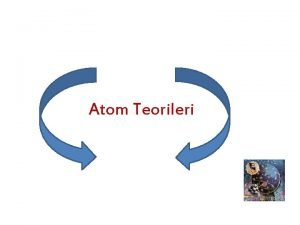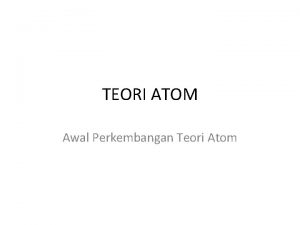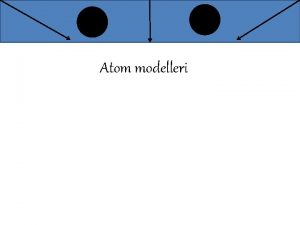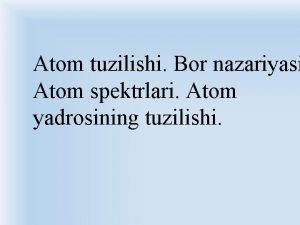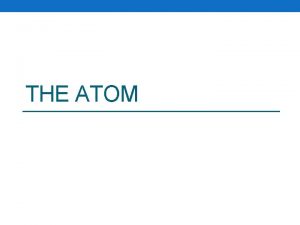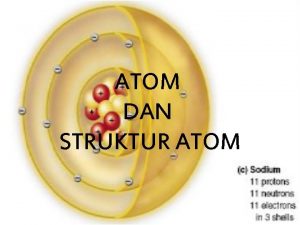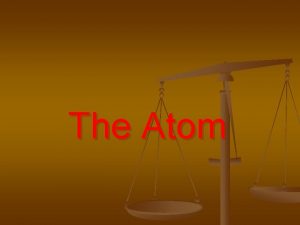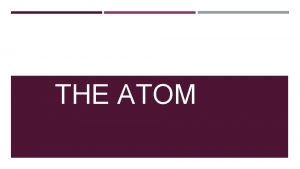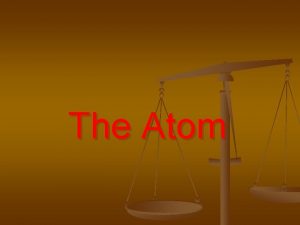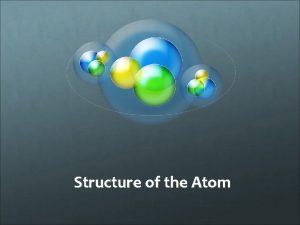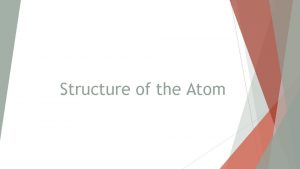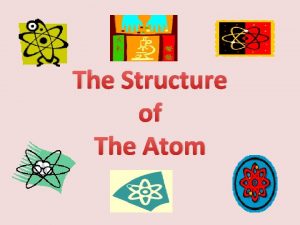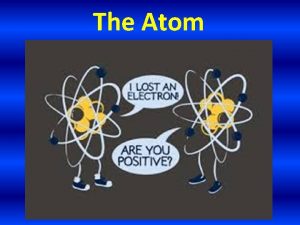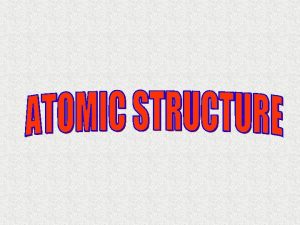Why was Daltons idea of the atom considered



























- Slides: 27

Why was Dalton’s idea of the atom considered a theory while Democritus’ idea was considered a hypothesis? A. B. C. D. Democritus was born in Thrace. Dalton had evidence to support his ideas. No one agreed with Democritus. Dalton had a college degree.

What statement about theories is correct. A. All scientists must agree with an idea for it to be considered a theory. B. Theories can be proven correct. C. Scientists usually create an entirely new theory when evidence is found that contradicts a current theory. D. Scientists modify theories to explain new evidence.

Dalton’s atomic theory is described by the four statements below. 1. All matter is composed of indivisible particles called atoms. 2. All atoms of the same element are identical. 3. Atoms of different elements combine to form compounds. 4. In a compound elements always combine in the same way. Which statement(s) are not part of the current atomic theory A. B. C. D. 1 only 2 only 3 only 4 only E. 1 and 2 F. 2 and 3 G. 1 and 3 H. 2 and 4

The central core of the atom is the A. B. C. D. Electron Neutron Nucleus Proton

What statement correctly describes the nucleus. A. The nucleus is a small, dense negatively charged center of the atom. B. The nucleus is the large volume of mainly empty space that contains the electrons. C. The nucleus contains most of the atom’s mass and is positively charged. D. The nucleus contains most of the atom’s volume and is positively charged.

What is a theory? A. A statement that describes what happens. B. A well tested idea that explains why things happen. C. A prediction of what will happen in an experiment. D. A visual, graphical or mathematical representation of an object or system.

What statement correctly describes electrons. A. Negatively charged particles found in the nucleus. B. Negatively charged particles found in the cloud around the nucleus. C. Neutral particles found in the nucleus. D. Positively charged particle found in the cloud around the nucleus.

Why do scientists create models to describe atoms? A. They are too small to see. B. They are too complex so we can’t understand what they would look like. C. They haven’t yet determined if they are real. D. They do not know what they are made of.

What statement best describes Thomson’s model of the atom. A. A ball of positive charge with negative charges scattered throughout. B. A cloud of negative electrons surrounding a positive nucleus. C. A cloud of positive electrons surrounding a negative nucleus. D. Solid, indivisible spheres.

What statement best describes the results of Rutherford’s experiment? A. A beam of particles bent towards the positively charged plate. B. Atom’s emitted light with different wavelengths when heated. C. Most of the alpha particles went straight through the gold foil but a few were deflected at large angles. D. Most of the alpha particles went straight through the gold foil but some were slightly deflected.

Based on his experiments, what did Rutherford infer about the atom. A. The atom consists of tiny electrons scattered throughout a ball of positive charge. B. The atom’s positive charge is clustered in a tiny area in the center of an atom. C. Electrons have very little mass. D. Electrons orbit the nucleus like planets around the sun.

What statement best describes Bohr’s model of the atom? A. Electrons orbit the nucleus in specific energy levels. B. Protons orbit the nucleus in specific energy levels. C. The nucleus contains both protons and neutrons. D. We need to use probability to predict where an electron will be located.

What is an isotope? A. Atoms of the same element with different numbers of electrons. B. Atoms of the same element with different numbers of neutrons. C. Atoms of the same element with different numbers of protons. D. Atoms of the same element with different numbers of electrons and neutrons.

Why are atoms neutral? A. They have neutrons in the nucleus. B. The number of protons is equal to the number of neutrons. C. The number of protons is equal to the number of electrons. D. There always more neutrons than protons.

What does the mass number of an atom tell us? A. B. C. D. Number of protons. Number of neutrons. Total number of protons and electrons.

What is the atomic number? A. The number of protons in an atom. B. The number of neutrons in an atom. C. The total number of protons and neutrons in the atom. D. The number of electrons or neutrons in an atom.

What do scientists currently believe about electrons in an atom. A. They move predictably so we will someday be able to locate them precisely. B. We can only use probability to predict where electrons will most likely be. C. They move in perfect circles around the nucleus. D. Electrons never can move from one energy level to another.

How is atomic mass of an element determined? A. The sum of the protons and neutrons in an atom. B. By the atomic mass of the most abundant isotope. C. The weighted average of all the isotopes of an element. D. Average of the atomic masses of the isotopes.

What specific isotope was used as a standard when assigning masses to the elements? A. B. C. D. Hydrogen-1 Helium-4 Carbon-12 Oxygen-16

What particle(s) have a relative mass of about 1 amu? A. B. C. D. E. F. Proton Neutron Electron Proton and electron Proton and neutron Neutron and electron

What particle did Chadwick discover? A. Proton B. Neutron C. Electron

What particle(s) are located in the nucleus? A. B. C. D. E. F. Proton Neutron Electron Proton and electron Proton and neutron Neutron and electron

What scientist developed the model of the atom shown? A. B. C. D. E. Dalton Thomson Rutherford Bohr de. Broglie, Heisenburg, & Schrodinger (Electron Cloud Model)

What scientist developed the model of the atom shown? A. B. C. D. E. Dalton Thomson Rutherford Bohr de. Broglie, Heisenburg, & Schrodinger (Electron Cloud Model)

What scientist developed the model of the atom shown? A. B. C. D. E. Dalton Thomson Rutherford Bohr de. Broglie, Heisenburg, & Schrodinger (Electron Cloud Model)

What scientist developed the model of the atom shown? A. B. C. D. E. Dalton Thomson Rutherford Bohr de. Broglie, Heisenburg, & Schrodinger (Electron Cloud Model)

What scientist developed the model of the atom shown? A. B. C. D. E. Dalton Thomson Rutherford Bohr de. Broglie, Heisenburg, & Schrodinger (Electron Cloud Model)
 Dalton atomic theory summary
Dalton atomic theory summary Daltons gas law
Daltons gas law Gaylussacs law
Gaylussacs law Efnisheimurinn kafli 2
Efnisheimurinn kafli 2 Daltons experiment
Daltons experiment Andreas carlsson bye bye bye
Andreas carlsson bye bye bye The structure of the atom section 2 defining the atom
The structure of the atom section 2 defining the atom Perkembangan teori atom dalton
Perkembangan teori atom dalton Why are viruses considered nonliving?
Why are viruses considered nonliving? A continuous strand of fibers that have been spun together
A continuous strand of fibers that have been spun together Why is accounting referred to as the language of business
Why is accounting referred to as the language of business Why is environmental science considered interdisciplinary?
Why is environmental science considered interdisciplinary? Lytic infection
Lytic infection Why stock is considered as the foundation of cooking
Why stock is considered as the foundation of cooking Why is plant breeding considered an art and a science
Why is plant breeding considered an art and a science Why is hair considered class evidence
Why is hair considered class evidence Is oceanography and interdisciplinary science?
Is oceanography and interdisciplinary science? Why are fibers class evidence
Why are fibers class evidence Hand signal
Hand signal Why is dna replication considered semiconservative
Why is dna replication considered semiconservative Why is alcohol considered a drug
Why is alcohol considered a drug Free vs blank verse
Free vs blank verse Why was cyrus considered a fair ruler
Why was cyrus considered a fair ruler Why is the senate considered a continuous body
Why is the senate considered a continuous body Civil war first modern war
Civil war first modern war Why is arson considered a low priority crime
Why is arson considered a low priority crime Why was cyrus considered a fair ruler
Why was cyrus considered a fair ruler The atom from philosophical idea to scientific theory
The atom from philosophical idea to scientific theory

